Industrial Rooftop Semi-Private Screen
PalmSHIELD’s line of fully framed products are a popular choice for rooftop mounted mechanical equipment. Because PalmSHIELD is the only architectural screen fencing manufacturer providing a structural picture frame design to fully enclose each panel; we are the number one choice for rooftop screen fencing.
Our fully framed panel system allows our rooftop screens great flexibility in spanning considerable widths and heights. All of our fully framed panels can be used with our rooftop screen fencing system or with any owner furnished structural framework, allowing for a variety of style, airflow, and level of visual screen fencing options. PalmSHIELD provides a width option of mounting brackets or will custom design mounts for your structural framing.
Progressive cities around the US are beginning to require rooftop screen fencing. No longer is the unsightly equipment meant to stand alone atop a commercial building. Now, it is often required for mechanical equipment and other unsightly areas to be screened with material that compliments the building envelope and surrounding area in a way that is pleasing to the eye. However, many mechanical equipment units have a certain airflow requirement. This is where PalmSHIELD comes in. Our upscale equipment screen fencing can be customized to meet any city appearance codes as well as manufacturer recommendations for mechanical equipment airflow. PalmSHIELD’s products do all of this while protecting expensive mechanical equipment from damage.
PalmSHIELD’s rooftop screen fencing can be incorporated into your building envelope in one of three ways.
- Panels OnlyPalmSHIELD to provide fully framed panels only to mount to your existing structural framework or new framework by others. PalmSHIELD provides a wide range of mounting brackets or will custom build brackets to your application.
- Panels and Rooftop Mounting FrameworkPalmSHIELD to provide panels and our exclusive rooftop mounting system for rooftop installation. PalmSHIELD provides panels, support posts, forty-five degree kickers and raised mounting rail.
- Panels and Direct to Equipment MountPalmSHIELD to provide panels, modified supports with cantilevered truss framework that will attach directly to the mechanical equipment rather than the rooftop.
FEATURES & BENEFITS
- Extraordinarily flexible
- Several rooftop screening mounting options
- Customizable to your application
POPULAR APPLICATIONS
- Retro existing mechanical equipment screening
- Replacing existing rooftop screening
- Parapet walls
- Sloped roofs
- Rubber EPDM roofs
- Limited attachments for rooftop attachments
Industrial Rooftop Semi-Private Screen

Design: Standard rectangular shape
Material: Homeland Composites, Vinyl, or Aluminum.
Thickness: 1”
Width: 5”, 5 ½”, or 6”
Post spacing: Up to 72” based on standard design.
Height: Heights may vary based on design. Standard heights up to 8’
Roof Mount Options: Elevated continuous rail, plated support posts, 45 degree kickers, cantilevered direct equipment attachment.
ROOFTOP MOUNTING OPTIONS
Rooftop Mounting Support Systems
Our rooftop mounting system supports all of our fully framed screen panel for added wind load resistance that “one-off” or “stick-built” systems simply can not match. The key to our rooftop mounting system is the rooftop equipment mounting rail, 45 degree kickers and mounting hardware. The rail runs perpendicular to the panels and attaches to the roof via bolts. The rails are installed to be water tight, preventing any roof leakage.
These rooftop rails or pedestals provide an economic option for rooftop equipment screen mounting. They provide a continuous nailer for the flashing attachment and a removable cap to create a watertight installation. These welded steel pedestals are perfect for the attachment of PalmSHIELD’s posts and kickers.
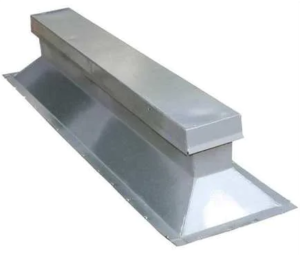
PalmSHIELD will provide aluminum square tube kickers that run at an angle from the far end of the mounting rail to the posts that our panels are mounted to, creating a triangle support. All of these elements are mechanically fastened together in the field via aluminum brackets and stainless steel bolts.
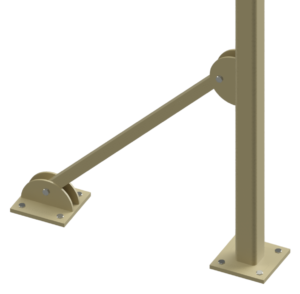
If you are unable to attach directly to the roof and must attach to the equipment, PalmSHIELD will provide a 24” or 36” aluminum cantilevered truss system that extends out from the equipment to the screen support posts. The cantilevered trusses will be equipped with brackets that match-up and mount direct to the posts. The trusses will also be custom designed to match-up with your equipment’s structural framework and attachment points.
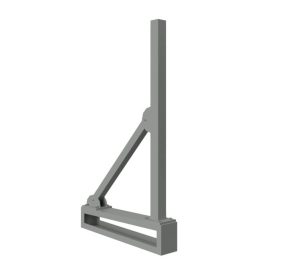 All panels are pre-punched and support posts are all pre-drilled and tapped where necessary for extreme ease of installation.
All panels are pre-punched and support posts are all pre-drilled and tapped where necessary for extreme ease of installation.
Wind loads across rooftops are even greater than those on the ground due to the compressed nature of the wind as it travels over the top of the building. PalmSHIELD’s structural frame is utilized at every post, creating a wind resistant fortress for maximum equipment protection.
Today’s roof systems do not always allow for penetration of the roofing and attachment to an available substructure. In most cases, it is just too difficult to attach to a structural substructure adequate to support rooftop screening and wind loading. Or the structural substructure is not reasonably located relevant to the screening. In this event, it may be necessary to attach to the equipment. This may only be done if the equipment is equipped with an external structural skeleton designed to support the rooftop screening.
PalmSHIELD’s cantilevered attachments are typically 36”-42” in width. Square aluminum tube typically stretches the height of the screening with attachment points top and bottom of the screening. The cantilevered brackets are fully framed with diagonal braces designed to support both the screening and wind load. These may be placed at every post and attached back to the equipment. PalmSHIELD recognizes that all equipment manufactures’ structural systems are unique to their brand thus we are accustom to designing custom brackets and points of attachment to the structure.
The Need for Rooftop Mounted Mechanical Equipment Screening
Progressive cities around the US are beginning to require rooftop screening. No longer is the unsightly equipment meant to stand alone atop a commercial building. Now, it is often required for mechanical equipment and other unsightly areas to be screened with material that compliments the building envelope and surrounding area in a way that is pleasing to the eye. However, many mechanical equipment units have a certain airflow requirement. This is where PalmSHIELD comes in. Our upscale equipment screening can be customized to meet any city appearance codes as well as manufacturer recommendations for mechanical equipment airflow. PalmSHIELD’s products do all of this while protecting expensive mechanical equipment from damage.
Beyond providing security and improving the curb appeal of a building, architectural screening provides protection for equipment from damaging high winds. Below is an excerpt from FEMA’s report on rooftop equipment in high-wind regions: “Observations after the 2017 hurricanes have once again shown that rooftop equipment is often damaged during high winds. Damaged equipment can impair the operation of the facility, and the equipment can detach and become damaging wind-borne debris. In addition, water can enter the facility where equipment was displaced or damaged.”
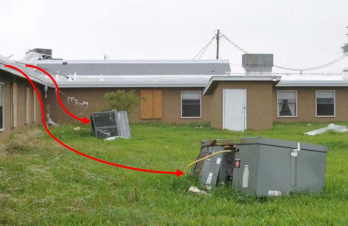
During high winds this mechanical equipment was removed from its foundations and the roof itself. Even mechanical equipment on a low roof is susceptible to high winds without an enclosure.
In a recent study by the Insurance Institute for Business & Home Safety and the American Society of Heating, Refrigeration, and Air Conditioning Engineers it was found that “fully enclosed screen wall configurations do lower wind loads on the equipment it protects”. An architectural screen engineered to meet the wind load codes set forth by the IBC and ASCE7-16 helps to protect expensive mechanical equipment and can save a business from unexpected expenses and difficulties associated with the loss of mechanical equipment.
When designing a project, an architect needs to be assured that the architectural screening used will be able to withstand a region’s wind load. So, how does a designer select screening that is engineered to survive a region’s wind load and protect a building’s mechanical equipment? By identifying manufacturers that provide engineered architectural screening and have a demonstrated track record and by avoiding the use of non-engineered systems such as the lattice fencing shown below.
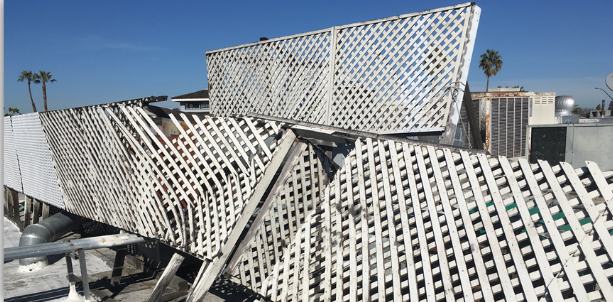 Though these lattice panels provide up to 50% opening, they still failed under 60 MPH winds.
Though these lattice panels provide up to 50% opening, they still failed under 60 MPH winds.Quality architectural screening should be designed for the wind load determined under section 29.5.1 of ASCE7-16. This is based on building risk category:
| Risk Category | Nature of Occupancy |
| 1 | Buildings and other structures that represent a low hazard to human life in the event of failure. |
| 2 | Buildings and other structures except those listed in Risk Categories 1, 3 and 4. |
| 3 | Buildings and other structures that represent a substantial hazard to human life in the event of failure. |
| 4 | Buildings and other structures designated as essential facilities. |
As a minimum, your rooftop screening should apply to risk category 3 wind loads.
In addition to ASCE 7-16 wind load requirements, architectural screening shall also meet the following: • Risk category: III • Wind Speed: 120 MPH • Exposure: C • Importance Factor: Open Sign Structure, Case A • PW: 33 PSF
Architectural screening manufacturers may have available baseline engineering for typical applications. However, site specific installations should be fully engineered and include stamped drawings provided by a registered engineer in that jurisdiction. Risk category, exposure, and wind speeds vary from site to site. Site specific engineering is critical for the protection of equipment, property damage and harm to others.
In summary, high winds can be detrimental to a facility’s ability to operate effectively. It is vital to protect the equipment that keeps a facility in working order. Designers should utilize only reputable manufacturers that engineer architectural screening to withstand the wind loads laid out in ASCE7-16. Avoid using one-off, stick built, non-engineered systems that will fail under high winds.
